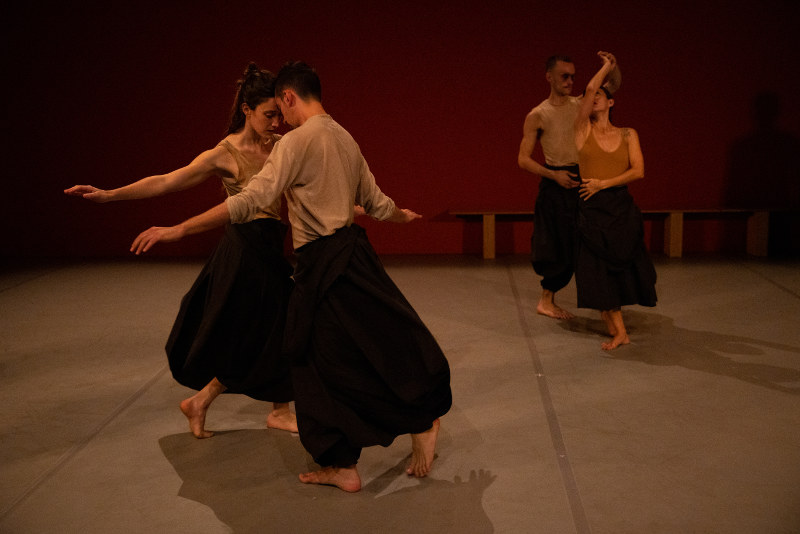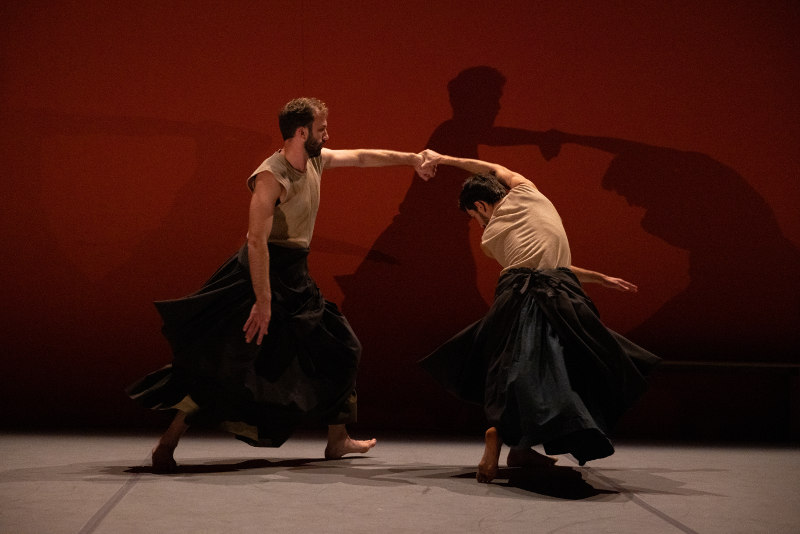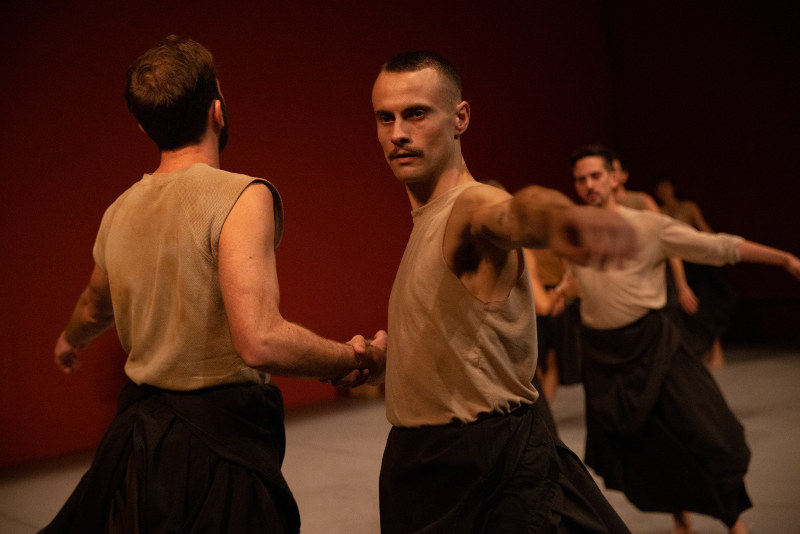
photo: marina baronova
The Vertigo Dance Company returned to New York’s Baryshnikov Arts Center this past weekend (Jan 12-14) with a timely new work, “Pardes.” The choreographic creations and dancing of this vibrant company from Israel continue to be an immersive, affecting experience. Founded thirty years ago by the wife and husband team, dancers Noa Wertheim and Adi Sha’al, Vertigo’s intention is to bring together art, humanity, and nature. The company performs the work of Wertheim, its prolific artistic director, who consistently gives palpable expression to the search for human connection to one another and the natural environment.
“Pardes,” the Hebrew word for “a garden of trees” or “orchard,” is also an acronym from Jewish mysticism for an approach to textual study─an inward process moving from the outer, or literal, interpretation to the most inner, secret meaning. During the Covid-19 pandemic, as the normal pace and business of the Vertigo Dance Company suddenly stopped, Noa and her creative collaborator (and sister) Rina Wertheim-Koren turned their attention inward for a process of research and discovery. Living, as they do, in an ecological art village (harvesting rainwater, using alternative energy, composting, and more), which the Vertigo founders and their extended family established on Kibbutz Netiv Halamed-Heh, they were able to continue creating despite lockdowns. In fact, they never stopped working. With a downsized group of local dancers (foreign dancers returned to their homes), they remained creatively engaged in their spacious, windowed studios—former kibbutz chicken coops!

“Pardes” opens onto a minimal set, where three walls are fully covered with orange-colored panels or screens, each lined with a long bench. The dancers enter with composure to sit on the benches in a state of quiet readiness. All draped in the same chic, black, gathered dresses (which later fold into skirts), they return to the benches when not dancing. Arising at the same moment, the eight dancers begin to move in unison. Establishing a side-to-side, repetitive, rhythmic, stepping pattern (and sound) with their feet, they perform a communal gesture dance to the unifying beat of the electronic score by percussion artist Itamar Doari. The chorus of hand and arm movements performed with a martial attack includes gripping, clasping hands to the heart, wiping the brow, crossing the chest, circling hands in front of the belly, guarding the face, and more to convey a myriad of emotions such as aggression, sadness, fatigue, self-protection, internal distress, desperation, internal processing, and others.
The central dance ground then becomes a space of healing—a place to express pain and needs, receive or give support and comfort, and even transform and transcend. Awash in the subdued glow of Dani Fishof’s lighting design, the dance evokes a connection to an ancient past when rituals were forged in community—especially when the dancers’ shadows loom large and multiply the onstage presence.
A mesmerizing duet danced by Sian Olles and Korina Fraiman begins as the dancers peel down the top of their dresses in a mutually revealing act. One’s cheek skims the other’s arm initiating a sensual encounter of configuring their bodies in a myriad of ways with varying degrees of closeness (often not even touching). The relational tension is poignantly captured when one grabs at the other’s skirt just as the dancer steps out of reach.

Later, in an uncharacteristic male to male interaction, Micha Amos offers embraces and partnering support to Etai Peri as Peri attempts ever-larger movements testing the reaches of expansive freedom. Amos counterbalances Peri by clasping his hands over Peri’s eyes, and then his waist, allowing Peri a cantilevered spin of utter abandon. Wertheim’s ability to mold sensitive, sensual, same sex duets that illustrate the relational possibilities between two human beings and their physical bodies is exceptional.
At one point, dancer Sian Olles stumbles from the group seeming to lose her way and her grip on reality. Reaching at nothing, she extends her arms and legs with a dreamy, seaweed-like quality. Returning to the group in her altered state, like a sleepwalker, she blindly falls from one dancer to another. The group responds in a protective effort to keep her aloft. This memorable scene is vividly reflected in Doari’s score with the echoed looping of the sound of a turntable needle stuck in the groove of a scratched LP.
Micha Almos explodes into the central space in a no-holds-barred solo. In a torrent of energy, he unguardedly dives onto his hands as his long legs shoot skyward. This flows into a breathtaking flip that tumbles down the stage’s diagonal onto the floor before regenerating into a new movement surge. This is a striking example of the energy that shapes the Vertigo movement language.

Noa Wertheim describes her movement-based language as deriving from the dancers’ training in contact improvisation, release technique, martial arts and its connected energy work, and a bit of ballet. Unlike many dance styles that are shape oriented, Vertigo’s movement is generated from the body’s weight, momentum, and qualitative energies. In “Pardes,” for example, the toes are energized but not pointed. Hip circles evolve into giant body swirls, partnered cantilevered spins, or gliding swirls on the floor.
Wertheim’s absorbing movement episodes are interspersed with full ensemble sequences, which feel like a healing ritual. The dancers sometimes form a line stretching across the stage to enfold or offer physical support to an individual. Sometimes they just do what dancers do—they dance. A simple folk dance step becomes a leitmotif for the ongoing “dance of life.” It pops up in partner sequences, country dance formations, and in one final, connected line that persists as the lights dim—pulsing, breathing, dancing.
photo credits: maria baronova
Karen Greenspan is a New York City-based dance journalist and the author of Footfalls from the Land of Happiness: A Journey into the Dances of Bhutan.
